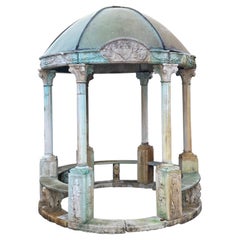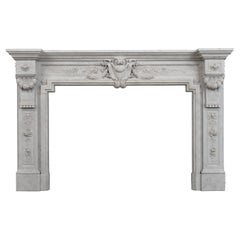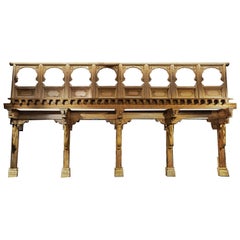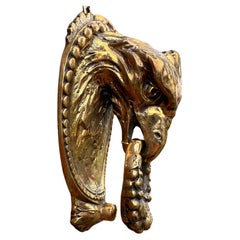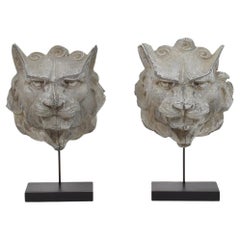19th Century Architectural Elements
to
260
770
513
1,306
Height
to
Width
to
105
83
74
51
46
39
30
25
21
17
17
13
8
3
719
1,306
1,224
434
408
402
228
52
10
87
64
31
69
78
79
15
20
490
419
378
307
239
957
458
229
180
140
1,306
1,306
1,306
9
5
2
2
1
Period: 19th Century
Set of 6 Old Dutch Hand Painted Delft Tiles by Royal Tichelaar Makkum, c. 1880
Located in Kenilworth, IL
Set of six old Dutch hand painted ceramic tiles attributed to Royal Tichelaar Makkum featuring scenes of equestrian cavaliers.
Netherlands, late 1800's.
Dimensions: 5-1/4" Square x ...
Category
Dutch Antique 19th Century Architectural Elements
Materials
Faience
Exquisite Rotunda Structure Kiosk Copper & Carved Stone Bench Seating Columns
Located in West Hollywood, CA
Exquisite Rotunda Structure Kiosk Copper & Carved Stone Bench Seating Columns . Monumental Exquisite refined work King Charles X Period Rotunda rotundus building structure with a circular ground plan covered by a large copper dome...
Category
French Charles X Antique 19th Century Architectural Elements
Materials
Stone, Copper
$232,000 Sale Price
20% Off
Superb Antique Louis XVI Fireplace Mantel
Located in Haarlem, Noord-Holland
Spectacular French Louis XVI style fireplace mantel in beautiful Italian Carrara white marble.
This mantel is decorated with exquisite and exuberant carvings. It is in a lovely cond...
Category
French Louis XVI Antique 19th Century Architectural Elements
Materials
Carrara Marble
Monumental 19th Century Indian Building Facade
Located in Chicago, IL
This magnificent building facade was once part of a grand mansion in Gujarat, India. It is entirely made from Teakwood, which is highly resistant to in...
Category
Indian Anglo Raj Antique 19th Century Architectural Elements
Materials
Teak
$84,000 Sale Price
30% Off
Antique & Monumental, Finest Bronze American Bald Eagle Sculpture Door Knocker
Located in Lisse, NL
Certainly the most impressive antique door knocker on 1stdibs.
This marvelously finest handcrafted and amazing condition antique door knocker is another one of our recent great finds. Can you imagine this fine bronze eagle head on your door? Having this gorgeous bronze door knocker made as the finishing touch, would have made this a real statement piece, and it still will be. Mind you, with a unique and all hand-crafted bronze door knocker of this size, quality and beauty suddenly in your face and you too would be impressed when showing up at this front door. Especially with the fierce looking eagle holding the wreath knocker in his beak staring at you. They really don't make 'em like this anymore and we are proud to be able to offer it to the 1stdibs community in such amazing condition.
Mind you, our price for this unique antique bronze door knocker...
Category
French Arts and Crafts Antique 19th Century Architectural Elements
Materials
Bronze
Pair 19th Century, French Zinc Mythical Lion- Wolf Head Fragments
Located in Buisson, FR
Beautiful and rare decorative zinc item that once graced a facade, France, circa 1850-1900
Weathered and small losses but despite of its age in a good condition
Measurement here belo...
Category
French Antique 19th Century Architectural Elements
Materials
Zinc
$679 Sale Price / set
41% Off
19th Century, French Zinc Mythical Lion- Wolf Head Fragment
Located in Buisson, FR
Beautiful and rare decorative zinc item that once graced a facade, France, circa 1850-1900
Weathered and small losses but despite of its age in a good condition
Measurement here belo...
Category
French Antique 19th Century Architectural Elements
Materials
Zinc
$679 Sale Price
35% Off
Late 19TH Century Cast Iron Lamp Post Base heavy decorative floral relief
Located in Buffalo, NY
Late 19TH Century Cast Iron Lamp Post Base heavy decorative floral relief ..Wonderful design,, 4-sided, (MATCHING) one panel removable (access pane...
Category
American Gothic Revival Antique 19th Century Architectural Elements
Materials
Iron
Pair of Painted Antique Columns with Corinthian Capitals
Located in Sheffield, MA
The pair of antique Corinthian columns are painted with a marblized effect on each base and shaft and have black capitals, above which are ce...
Category
European Classical Roman Antique 19th Century Architectural Elements
Materials
Wood
Antique Relief Tile Panel in the Style of J. Parentani, 1890
Located in Rijssen, NL
Stunning Art Nouveau/ Arts & Crafts tile panel from the superb firm, Craven Dunnill, & Co., Ltd, Jackfield Salop, England, circa 1905, in a bright celadon. This quantity original jug...
Category
French Medieval Antique 19th Century Architectural Elements
Materials
Earthenware, Pottery
3 English Georgian Carved Mahogany Archways
Located in Queens, NY
3 English Georgian style (19th Century ) mahogany carved archways with oak and laurel leaf design (Belmont Estate, Long Island)(PRICED EACH). Related it...
Category
Georgian Antique 19th Century Architectural Elements
Materials
Mahogany
$25,000 / item
Oversized Cast Iron 19th century Enterprise Coffee Grinder, Philadelphia
Located in Milford, NH
A fine example of an oversized cast iron 19th century polychrome hand crank coffee grinder embossed with “Enterprise Mfg Co, Philadelphia USA” on each wheel and on base, “ Pat Oct 2...
Category
American Antique 19th Century Architectural Elements
Materials
Iron
Mid 19th Century Pair of Monumental Antique Architectural Bronze Door Knockers
Located in Stamford, CT
Mid to late 19th century monumental antique architectural pair of bronze door knockers, the largest I have even seen. This amazing pair of door knockers...
Category
Antique 19th Century Architectural Elements
Materials
Bronze
$14,400 Sale Price / set
20% Off
Gilt Lion Ring Handled Bridle Hitch
Located in New York, NY
Gilt lion ring handled bridle hitch. Antique metal lion equestrian ring handle mask for hitching horses. American 19th century
Dimensions: 4.75" diameter x 2.5” deep ; 6” to bottom...
Category
American Neoclassical Antique 19th Century Architectural Elements
Materials
Metal
Wood Sculpture Container from Old Water Mill Gear, China 1800-40
Located in Round Top, TX
This wood accent piece originally served as a section of gear work from a water mill in China. The deep worn patina of the rich hard wood is warm and inviting. May be used as a conta...
Category
Chinese Chinese Export Antique 19th Century Architectural Elements
Materials
Wood
Pair of 19th C. Italian Stone Artichokes
Located in Los Angeles, CA
Pair of 19th century weathered stone artichoke finials. They are all hand chiseled and have bulbous shapes with a layered, petal-like pattern coverin...
Category
Italian Classical Roman Antique 19th Century Architectural Elements
Materials
Stone
$1,200 Sale Price / set
50% Off
Early Dutch Antique Brass Bird Cage
Located in Haddonfield, NJ
Early 19th century brass bird cage, circa 1810-1830
The bird cage has two bird seed containers that attaches to the cage.
Category
Dutch Baroque Antique 19th Century Architectural Elements
Materials
Brass, Iron
$1,000 Sale Price
39% Off
Antique French PAIR BUFFET WINE Doors Hand Painted Menus Bar Wine Cellar Oak 19C
Located in Tyler, TX
EXQUISTE Antique French PAIR of Oak WINE Buffet Doors~~Early 19th Century
Fabulous pair of painted wine doors can be hung on the wall of any bar or game roo...
Category
French Renaissance Revival Antique 19th Century Architectural Elements
Materials
Oak
19th Century Gilt Wood Fragment Architectural Sculpture, France
Located in Haddonfield, NJ
French Gilded Wood Rococo Wall or Table Fragment.
Beautiful period Rococo design constructed in gilt wood featuring intricate scroll motifs throughout as well a small old mirrored ...
Category
French Rococo Antique 19th Century Architectural Elements
Materials
Wood, Giltwood
French 19th Century Neo Gothic Marble finial
Located in Buisson, FR
Wonderful small architectural fragment.
White marble finial in Gothic style.
France circa 1850. weathered.
Measurements include the wooden base.
Category
French Gothic Revival Antique 19th Century Architectural Elements
Materials
Marble
$466 Sale Price
31% Off
Antique Wrought Iron Decorative Transom
Located in Redding, CT
Antique wrought iron decorative Transom or window guard. Lovely half moon shape with detailed scroll work.
Some restoration done to piece. See photos. Perfect ornamentation for above...
Category
Art Nouveau Antique 19th Century Architectural Elements
Materials
Iron
$1,000 Sale Price
54% Off
Antique Fireplace Mantel
Located in Made, NL
Antique Nero Marquina Fireplace in Louis XVI Style
This rare antique fireplace made from Nero Marquina marble is a stunning example of the re...
Category
French Louis XVI Antique 19th Century Architectural Elements
Materials
Marble
$11,513
19th Century Hand Painted Wood Puto Architectural Element
Located in Douglas Manor, NY
1850 Carved polchromed and gilt wood puto architectural element
Category
Antique 19th Century Architectural Elements
Materials
Giltwood
Antique Mantel
Located in Made, NL
Antique Paonazzo Marble Chimneypiece for Sale
There is something undeniably captivating about an original antique fireplace mantel, especially one crafted from a rare and beautif...
Category
French Louis XIV Antique 19th Century Architectural Elements
Materials
Marble
$20,707
19th Century Moroccan Antique Double Door with Hand Painted Moorish Designs
Located in Moreno Valley, CA
Moroccan huge antique doors from a Ryad in Fez, amazing hand painted artwork.
Multicolored geometrical Moorish designs in deep red, green, yellow.
Moroccan doors and furniture is most noted for the use of beautiful Moorish hand-painted and hand carved designs colorfully applied to wood.
Many of the Moorish influenced designs have been used for centuries decorating the ceilings and wall panels of Mosques and Palaces all around Islamic countries.
Great patina, different designs in front and back, great o use as a piece of architectural design on a wall.
Bottom and top show damages, distressed look.
The two doors have a different design and different colors, they don't match.
They could be used on walls as a decorative architectural panel.
Iron locker...
Category
Moroccan Moorish Antique 19th Century Architectural Elements
Materials
Wood
$7,880 Sale Price
20% Off
Large Late 19th Century French Double Door in Original Paint
Located in Dusseldorf, DE
Large French double door from the late 19th century. Made of solid pine wood in the original paint.
Doors made in frame construction with 4 cassettes each.
Very beautiful origi...
Category
French Belle Époque Antique 19th Century Architectural Elements
Materials
Pine
Late 19th Century Antique Stained Glass Window with Flowers and Jewels
Located in Stamford, CT
Beautiful late 19th century antique stained glass window with flowers and jewels. This is a great window with good colors from a private billiards room in Fairfield County Ct. Original salvaged from an estate in northern New Jersey over 40 years ago. It has some small cracks shown in the photos but is very sturdy and in very good condition. The sizes are for the stained glass window in a small wood frame...
Category
American Antique 19th Century Architectural Elements
Materials
Stained Glass, Wood
$6,960 Sale Price
20% Off
Pair of antique wood carved Gothic Revival architectural Columns
Located in Leesburg, VA
Pair of antique wood carved Gothic Revival architectural Columns
Anonymous
19th century; Belgium or Netherlands
Wood
Approximate size: 41.75 (h) x 11.75 (w) x 11.75 (d) in.
An exceptional pair of tall and intricate hand carved vintage wooden 19th century church columns...
Category
Belgian Gothic Revival Antique 19th Century Architectural Elements
Materials
Wood
Suprising Antique Louis XV Fireplace Mantel
Located in Haarlem, Noord-Holland
Beautiful and surprising 19th century French Louis XV Rococo style fireplace mantel in white marble.
The perfect dimensions and decorations truly make this mantel stand out.
Lo...
Category
French Louis XV Antique 19th Century Architectural Elements
Materials
Marble, Carrara Marble
Pair Of Grand Scale French Iron Lions' Heads
Located in Round Top, TX
A very impressive grand scale pair of Napoleon III 19th century Lions' Heads beautifully cast in iron. A wonderful statement for any entryway.
Category
French Antique 19th Century Architectural Elements
Materials
Iron
$15,500 / set
Antique Marble Fireplace with Cast Iron Stove
Located in Haarlem, Noord-Holland
Amazingly colorful French Louis XV fireplace mantel from Paris, France.
This bright and friendly pompadour style mantel comes with cast iron stove and...
Category
French Louis XV Antique 19th Century Architectural Elements
Materials
Marble, Breccia Marble
Small Square Antique Fireback / Backsplash
Located in Haarlem, Noord-Holland
Nice and decorative square cast iron fireback / backsplash displaying a female figure doing laundry and other house hold chores.
Great original condition and nice patina.
Can be pla...
Category
French Antique 19th Century Architectural Elements
Materials
Iron
$448 Sale Price
20% Off
Factory or Ore Industrial Cart 19th Century
Located in Fulton, CA
Heavy gauge steel industrial cart / dolly with large cast iron spoke wheels. Four smaller castor wheels. Probably used in a factory to move material for production. Designed to hold ...
Category
American Industrial Antique 19th Century Architectural Elements
Materials
Steel
Antique fireplace of carrara marble, Louis XVI style, 19th century
Located in Made, NL
This antique mantelpiece from the 19th century is made of high-quality Carrara marble from Italy. The Louis XVI-style design is characterized by sleek lines, graceful details and a c...
Category
French Louis XVI Antique 19th Century Architectural Elements
Materials
Marble
Gilded 19th Century Wooden Urn-Shaped Rococo Table Lamp
Located in Copenhagen, K
This 19th century Rococo-style, gilded and painted in blue and red table lamp, featuring an decorative urn shaped body with side handles carved in wood. The lamp is raised on a squar...
Category
French Rococo Antique 19th Century Architectural Elements
Materials
Wood
$777 Sale Price
44% Off
19th Century Wrought Iron Lunette or Fan Light
Located in Baltimore, MD
Arched ironwork features landed and riveted components. Metal work is structurally sound with no losses.
Category
Antique 19th Century Architectural Elements
Materials
Wrought Iron
Copper Over Cast Iron Column Fragment from the Chicago Stock Exchange
Located in Round Top, TX
Copper over cast iron column fragment from the elevator pilasters at the Chicago Stock Exchange. Louis Sullivan, architect.
Category
North American Antique 19th Century Architectural Elements
Materials
Copper, Iron
Antique Italian/French Gothic Grotesque Gargoyle & Cherubs Brass Door Knocker
Located in San Diego, CA
Very unique antique cast brass Italian/French Gothic cast brass door knocker. Great design and form featuring two cherubs and a grotesque gargoyle. ...
Category
Swiss Antique 19th Century Architectural Elements
Materials
Brass
$960 Sale Price
20% Off
Carved and Painted Wooden Eagle with Shield Attributed to John Haley Bellamy
Located in Savannah, GA
In all original untouched condition including weathered paint, this wonderful Folk Art wall plaque speaks for itself. Substantial size. It looks to be made to be mounted on a ledge, ...
Category
American Federal Antique 19th Century Architectural Elements
Materials
Wood
$9,713 Sale Price
24% Off
Cast Iron Lion and Unicorn
Located in Leamington Spa, Warwickshire
19th C cast iron lion and unicorn with original paint. 1860.
Unicorn dimensions: 26" W x 4" D x 18" H.
Lion dimensions: 27" W x 5" D x 14" H.
...
Category
English Victorian Antique 19th Century Architectural Elements
Materials
Iron
$2,174 / set
Set Chinese Carved Panels Screen Room Divider 1880
Located in Potters Bar, GB
Gorgeous set of four hand carved Chinese screens
These were originally part of a screen or room divider and could be put back together to serve that purpose if required
Good size at ...
Category
Chinese Export Antique 19th Century Architectural Elements
Materials
Wood
Antique Patent Safe, English Cast Iron Lock Box, Milners of Liverpool, Victorian
Located in Hele, Devon, GB
This is a heavy antique Patent fireproof safe. An English, cast iron lock box by Milners of Liverpool, dating to the Victorian period, circa 1870.
Superb example of Milners’ renowned 212 Patent fireproof model
Exceptionally robust cast iron construction with fire-resistant lining
Distinctive deep green exterior finish with appealing aged patina
Striking relief medallion to fascia, bearing Milners of Liverpool maker’s mark
Secondary lid plaque features coat of arms motif and engraved details
Lid opens smoothly and remains upright via hinged internal stays
Attractive bright green interior offers pleasing contrast and practical storage
Fascia hosting a lock escutcheon — in working order, key present
Equipped with stout carry handles to each side for two-person lift
Ideal as a unique statement piece for office, hallway, or retail interior
This antique Milners safe...
Category
British Victorian Antique 19th Century Architectural Elements
Materials
Iron
19th Century French Pair of Antique Pinewood Garden Treillis Obelisks
Located in West Palm Beach, FL
An antique pair of tall treillis obelisks in Versailles green topped by pointed finials, in good condition. These antique hand crafted painted Pinewood obelisks have multiple layers ...
Category
French French Provincial Antique 19th Century Architectural Elements
Materials
Pine
Antique Art Nouveau Italian Marble Sculpture
Located in Douglas Manor, NY
Hand curved Art Nouveau white marble bust of a young woman. Her elaborate hat framing a beautiful face. The style of clothing of the late 19th century Art Nouveau period. The bust rest on a round marble pedestal...
Category
Italian Antique 19th Century Architectural Elements
Materials
Alabaster
$1,340 Sale Price
44% Off
Teakwood Architectural Temple Pediment
Located in Chicago, IL
This giant architectural element once graced the pediment of a Northern Thai temple. It is from Chiang, Mai, Thailand and entirely made from Teakwood, which is naturally resistant ...
Category
Thai Antique 19th Century Architectural Elements
Materials
Teak
$3,750 Sale Price
25% Off
Antique Architectural Wall Building Anchor Star 19th Century
Located in Lambertville, NJ
An iron architectural building star anchor mounted on a steel base. The 19th Century star is originally part of a brick building and used to anchor in to...
Category
American Industrial Antique 19th Century Architectural Elements
Materials
Steel, Iron
Sullivan Designed Terra Cotta Fragment from the Chicago Stock Exchange
Located in Round Top, TX
A wonderful Louis Sullivan designed terra cotta fragment from the Chicago Stock Exchange, 1893, by the legendary firm of Adler & Sullivan. On a custom wall mount.
Category
American Antique 19th Century Architectural Elements
Materials
Terracotta
Antique Carrara marble fireplace in Pompadour style, 19th century
Located in Made, NL
This elegant antique fireplace, made of refined Carrara marble, comes from France and exudes the charm of the 19th century. With graceful lines and subtle details, it is a timeless v...
Category
French Other Antique 19th Century Architectural Elements
Materials
Marble
Pair of Antique Architectural Column Capitals
Located in Doylestown, PA
A pair of large glazed terracotta columns capitals reportedly from a New York building, circa 1890.
Category
American Neoclassical Antique 19th Century Architectural Elements
Materials
Terracotta
$1,200 Sale Price / set
31% Off
Dutch 19th Century Carved Mahogany Transom
Located in Baton Rouge, LA
A dramatic frame of carved mahogany found in the Netherlands, likely a 19th century architectural detail such as a transom above a doorway. This pierced window is without glass allow...
Category
Dutch Georgian Antique 19th Century Architectural Elements
Materials
Mahogany
Antique French Corinthian Capital
Located in Austin, TX
Corinthian Capital, French, of finely hand carved wood finished with 24 carats gold leafing. The architectural element which can serve as a side table features a hand carved décor o...
Category
French Classical Greek Antique 19th Century Architectural Elements
Materials
Gold Leaf
Polychrome Terracotta Angel
Located in Baltimore, MD
A polychrome terracotta angel built in fifteen pieces, in the Luca Della Robbia tradition, salvaged from the Southern Hotel in downtown Baltimore, wh...
Category
American Beaux Arts Antique 19th Century Architectural Elements
Materials
Terracotta
Pair of Antique French Renaissance Style Carved Wood Architectural Wall Panels
Located in Houston, TX
Great pair of well carved French Renaissance style or French Baroque style relief carved architectural walnut wooden panels or fragments from the 19th century.
These beautifully carv...
Category
French Greco Roman Antique 19th Century Architectural Elements
Materials
Wood
Classic French Antique Fireplace Surround in Royal Breche D'aleppo Marble
Located in Beervelde, BE
Exclusive antique fireplace surround in the richly colored Royal Breche D’ Aleppo marble. This mantel is in perfect condition. You feel the hand of the maker when you run your finger...
Category
Belgian Louis XIV Antique 19th Century Architectural Elements
Materials
Marble
Large Hand Forged Wrought Iron Candle Chandelier for Dining Room, Restaurant Etc
Located in Lisse, NL
Museum quality, forged in fire, Medieval castle-design chandelier.
This excellent quality AND condition pendant is all hand-forged and its design and perfect execution lifts it abov...
Category
Dutch Arts and Crafts Antique 19th Century Architectural Elements
Materials
Wrought Iron
Large Belgian Neo-Gothic Painted and Giltwood Architectural Element
Located in San Francisco, CA
Of Neo-gothic style and large scale with a protruding cornice carved with a meandering foliate vine; above an openwork body with trefoil and quatrefoil pierced reserves over a pointe...
Category
Belgian Gothic Revival Antique 19th Century Architectural Elements
Materials
Wood
Antique Fireback, Small and Decorative
Located in Haarlem, Noord-Holland
A nicely decorated gem of a fireback or backsplash, displaying a monkey and cat playing in a fireplace mantel.
Hollow casted so its relatively light, would make a great wall decor...
Category
French Louis XVI Antique 19th Century Architectural Elements
Materials
Iron
$544 Sale Price
20% Off
Monumental Pair of Italian Neoclassical Marble Columns
Located in Rome, IT
This outstanding pair of yellow "Breccia di Siena" precious Doric marble columns raised on a white Carrara marble square base with a large molded socle above. Finely carved iconic Io...
Category
Italian Neoclassical Antique 19th Century Architectural Elements
Materials
Marble
Carved Stone Water Filter
Located in Round Top, TX
Carved stone water filter from the frontier region of Argentina.
Category
Argentine Antique 19th Century Architectural Elements
Materials
Stone
Rare Hand Carved Stone Wellhead Cistern Basin Antique Fountain Focal Point LA CA
Located in West Hollywood, CA
Rare hand carved stone Wellhead cistern Basin Antique Fountain Focal point LA CA. 19th Century Neogothic Water Wellhead hand carved stone planter Basin ...
Category
French Gothic Revival Antique 19th Century Architectural Elements
Materials
Stone, Limestone, Iron, Wrought Iron
$96,000 Sale Price
23% Off
Recently Viewed
View AllMore Ways To Browse
Iron Window Grille
Large Garden Mirrors
Limestone Gargoyle
Limestone Pillars
Marble Seashell
Pair Door Knockers
Spanish Wood Beam
Stone Carved Keystone
Stone Caryatid
Talavera Tiles
Terra Cotta Finial
Terracotta Capital
Victor Horta Art Nouveau
Walter Macfarlane
Wrought Iron Transom
Amber Glass Door
Antique Brass Finger Plates
Antique Cast Iron Grills

